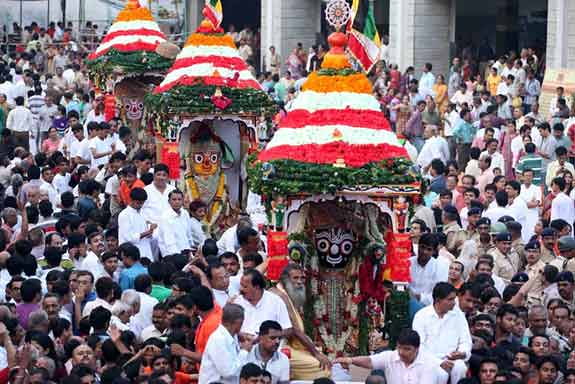


On Sunday, the annual Rath Yatra of Lord Jagannath began with much jubilation and excitement in Ahmedabad. The event, which draws in lakhs of devotees, also saw high security measures being taken, with over 15,000 police personnel deployed and the use of technology such as CCTV and drones. Union Home Minister Amit Shah and Gujarat CM Bhupendra Patel were also present for the festivities.
Rath Yatra: A Journey of Faith and Heritage in Ahmedabad
The annual Rath Yatra, a grand religious procession of Lord Jagannath, is an iconic event in the city of Ahmedabad. This year's yatra commenced on Sunday, July 10th, with immense fervor and a massive turnout of devotees.
Historical Roots
The Rath Yatra tradition in Ahmedabad dates back to the 16th century when Lord Jagannath was brought to the city by migrants from Odisha. The procession symbolizes the journey of Lord Jagannath, his brother Balabhadra, and sister Subhadra from their temple in Jagannath Puri to their summer residence, the Gundicha Temple.
The Procession
The chariots carrying the deities are elaborate structures adorned with intricate carvings and colorful decorations. The towering Rath of Lord Jagannath is approximately 50 feet tall, while the other two chariots are slightly smaller. The procession, which stretches for several kilometers, includes priests, devotees, musicians, and dancers.
High Security Measures
Given the immense crowd size, stringent security arrangements were in place. Over 15,000 police personnel were deployed, along with CCTV surveillance and the use of drones. Union Home Minister Amit Shah and Gujarat Chief Minister Bhupendra Patel attended the festivities to ensure a smooth and peaceful procession.
Religious Significance
The Rath Yatra holds deep religious significance for Hindus. It is believed that witnessing the procession brings good fortune and blessings. Devotees eagerly participate in the event, offering prayers and donations. The yatra also fosters a sense of community and unity among the people of Ahmedabad.
FAQs
1. When did the Rath Yatra originate in Ahmedabad? Answer: The Rath Yatra tradition in Ahmedabad dates back to the 16th century.
2. What is the significance of the three chariots? Answer: The chariots carry Lord Jagannath, his brother Balabhadra, and sister Subhadra.
3. How long does the Rath Yatra procession take? Answer: The procession takes approximately seven days to complete its journey from Jagannath Temple to Gundicha Temple.
4. What are the security measures implemented during the Rath Yatra? Answer: Stringent security arrangements are in place, including heavy police deployment, CCTV surveillance, and the use of drones.
5. What is the cultural impact of the Rath Yatra? Answer: The Rath Yatra fosters a sense of community and unity among the people of Ahmedabad and attracts visitors from around the world.

In a tense meeting at the White House, President Donald Trump urged Ukrainian President Volodymyr Zelensky to accept Russian President Vladimir Putin's terms for ending the two-year war in Ukraine. Despite seeking more military support from the US, Zelensky was met with resistance from Trump, who reportedly engaged in a "screaming match" with the Ukrainian leader. The US leader even claimed that Putin saw the conflict as a "special operation" rather than a full-fledged war, further complicating negotiations between the two nations.

As Liverpool struggled to find their form in a tough game against Manchester United, Dutch midfielder Cody Gakpo stood out with his sharp attack and strong composure. Despite hitting the woodwork three times, Gakpo managed to score a brilliant equalizer for his team, showcasing his potential and talent on the field. While Liverpool may have lost the match, Gakpo's impressive performance provided a glimmer of hope for a struggling team.

Ayodhya's Deepotsav 2025 was a shining example of faith, community, and innovation as the city set two new world records with over 26 lakh diyas and a grand aarti performed by 2,100 priests. The event, witnessed by Chief Minister Yogi Adityanath, also showcased a spectacular 3D projection mapping and drone light show that brought Lord Ram's story to life in the night sky. The event was a testament to the deep connection Ayodhya's youth have with Lord Ram's ideals and was made possible by the hard work of over 40 potter families and thousands of volunteers.

In a brazen and perfectly orchestrated robbery, a group of thieves infiltrated the world-famous Louvre Museum in Paris on Sunday morning and made off with a collection of priceless jewels with an estimated value in the millions. French officials confirmed the robbery and began a detailed investigation to determine how the culprits managed to evade the museum's advanced security systems and execute the crime in under seven minutes. This latest incident has raised serious concerns about the protection of national treasures at one of the world's most popular tourist destinations.

In an audacious heist, a group of armed thieves breached security at the iconic Louvre Museum in Paris and stole nine valuable jewels from the collection of Napoleon Bonaparte and Empress Joséphine. The robbery, which took place in just seven minutes, has prompted a full-scale police investigation and raised concerns about the museum's security. French officials are working to recover the stolen items, but the Louvre remains closed to visitors.

Despite a ceasefire in early October, the conflict between Israel and Palestine shows no signs of abating, with reports of ongoing deadly clashes and Israeli tank fire targeting a car in Gaza City. The closure of the Rafah border crossing to Egypt, citing Hamas's failure to retrieve bodies, has further exacerbated tensions. However, experts warn of the uncertain future for a transitional government in Gaza and the risk of breaching the fragile ceasefire. The violence and closure highlight the ongoing humanitarian crisis and the need for both sides to engage in peaceful negotiations.

Hundreds of travellers heading to India from Italy for Diwali were left stranded after Air India cancelled its Milan-Delhi flight due to a technical issue. The sudden breakdown of the flight raised concerns about making it home in time for the festival. Some passengers even face the prospect of celebrating Diwali away from home due to rebookings on alternate flights. Air India assured that they are prioritising passenger safety and comfort while providing necessary support to those affected.

On day 1,312 of Russia's war on Ukraine, tensions continue to escalate as Ukrainian drones target a Russian oil pumping station, Russian forces seize three more villages in eastern Ukraine, and NATO increases its presence in the Baltic Sea region. In response to the ongoing conflict, the Ukrainian security service reports that the SBU caused a fire and halted operations in the Chuvashia region, while Russia's military announced its continued advance in Donetsk and Dnipro. Meanwhile, NATO's decision to deploy additional military assets comes after several days of unidentified drone sightings in Denmark and at military bases.

The upcoming India-Australia ODI series has drawn attention for multiple reasons, including the successful return of Rohit Sharma and Virat Kohli as white-ball players. Despite being relieved of captaincy, the duo is expected to continue playing in the format until the 2027 World Cup, according to Australia's Travis Head and India's Axar Patel. As both teams gear up for a high-stakes clash, the focus remains on the future of these two icons and their potential to lead India to another ODI World Cup victory.

Pakistani security forces have thwarted a suicide attack targeting their camp in Mir Ali, North Waziristan, after a vehicle loaded with explosives was driven into the perimeter wall. In a separate operation, 34 militants described as "India-backed terrorists" were killed in multiple engagements across Khyber Pakhtunkhwa. These operations form part of Pakistan's continued efforts to eliminate foreign-sponsored terrorism from the country under the vision "Azm-e-Istehkam."